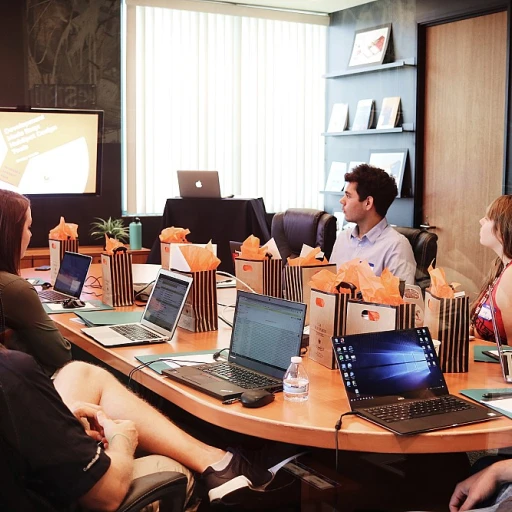
Understanding Observational Learning
Exploring the Concept of Learning by Observation
Observational learning, often synonymous with vicarious learning, is a fundamental type of learning that occurs through watching the actions and outcomes of others, a process pioneered by the psychologist Albert Bandura. This method of acquiring knowledge is particularly beneficial in various settings, including the workplace, where employees learn by observing the behaviors, skills, and experiences of their peers. The process of this social learning is crucial as it allows individuals to gain insights and develop skills without direct personal experience. By observing others, people can learn not only what to do but also what not to do, thus enhancing their problem-solving capabilities in real-life situations. This become especially important in corporate training environments, where new employees can quickly integrate and adapt by witnessing real-life examples of best practices. Observational learning can be harnessed through multiple mediums. While traditional techniques like reading books and attending face-to-face training sessions remain effective, modern approaches such as video demonstrations and interactive workshops are increasingly being used to facilitate this learning process. These methods not only improve knowledge retention but also cater to different learning preferences among employees. The benefits of vicarious learning are numerous. Not only does it foster a deeper understanding of workplace dynamics, but it also empowers employees by providing them with practical examples that can be replicated. These experiences significantly contribute to personal and professional development, ensuring that learning is both dynamic and continuous. To delve deeper into how skilled trainers and facilitators enhance onboarding through this approach, you can explore further here.The Role of Observational Learning in Onboarding
Capitalizing on Observational Learning for Employee Onboarding
Harnessing the power of observational learning, also known as vicarious learning, offers significant benefits in a corporate setting. When employees learn through observing others in the workplace, they not only gain knowledge but also internalize organizational behaviors and skills crucial for their role. This type of learning is pivotal as it allows new employees to acclimate more naturally to their new environment by mimicking the experienced individuals around them. The benefits of vicarious learning in onboarding are multifaceted:- Knowledge Retention: Learning by observing peers often leads to better retention of information. Witnessing practical application of skills and processes helps solidify knowledge.
- Behavioral Adoption: Employees can quickly adapt to the company's culture and behavioral expectations by observing real-life examples of professional interactions.
- Development of Social Skills: Observing workplace dynamics enables employees to develop essential social skills that scholarly reading or formal training might not cover extensively.
- Enhanced Problem Solving: By observing how experienced staff tackle workplace challenges, new employees can develop critical problem-solving abilities.
Implementing Observational Learning Strategies
Creating a Culture of Learning: Implementing Observational Strategies
To successfully weave observational learning into the onboarding fabric, it's essential to develop concrete strategies that nurture a culture of social learning in the workplace. Let's dive into how organizations can effectively utilize observational learning techniques during the onboarding process.Foster a Collaborative Environment
A thriving workplace environment that encourages collaboration and open communication is key to maximizing the benefits of vicarious learning. By integrating open spaces and teamwork-centric projects, new employees have opportunities for observing behaviors and adopting desirable skills and practices from seasoned coworkers.Utilize Concrete Tools and Resources
An indispensable component of implementing observational learning includes the use of tools that facilitate this learning type. Video demonstrations and real-life case examples allow employees to experience vicarious learning without directly encountering these situations themselves. Additionally, mentorship programs serve as practical learning experiences, where employees can observe knowledge and behaviors firsthand.Encourage Participation and Feedback
Engaging new hires in observational learning also involves encouraging active participation. This includes promoting inquiry, discussion, and feedback on the processes they witness. Observing people also requires reflection, where employees learn through experiences, thus significantly enhancing their knowledge retention.Provide Guidance and Support
For observational learning to succeed, employees must have guidance from competent trainers and mentors. By instilling confidence and support, trainers help groom new hires and ensure they absorb practical skills essential for their development. Thus, alongside observational techniques, trainers play a crucial role in aligning learning processes with organizational goals. A comprehensive approach, incorporating these best practices, ensures that the onboarding experience is not only informative but transformative as well. Visit our blog for more insights on how to enhance onboarding strategies effectively.Challenges and Solutions
Addressing Common Obstacles and How to Overcome Them
When implementing observational learning in the onboarding process, it's common to encounter certain challenges. These challenges can hinder employees' ability to effectively learn and absorb new skills and knowledge. However, by understanding these obstacles and knowing how to navigate them, organizations can enhance their learning workplace environments.
Lack of Structure
A primary challenge is the lack of a structured approach. Without a clear process, employees might not know what behaviors to observe or which skills need focus during their observing phase. Creating a structured plan aids in overcoming this hurdle. Using a mix of video demonstrations and real-life scenarios provides a roadmap for learners.
Insufficient Resources
Access to resources is crucial for immersive learning experiences. Facilitators should ensure employees have access to social learning opportunities, whether through interacting with peers, engaging with learning videos, or accessing a well-curated reading book collection. This will enhance knowledge retention and ensure continuous development.
Resistance to Change
Another obstacle is resistance to change. Employees might be reluctant to embrace new learning techniques, perceiving them as challenging or irrelevant. To tackle this, communicating the benefits of vicarious learning can be pivotal. Showcasing success stories or examples of vicarious learning results can ease apprehensions and foster a welcoming attitude toward new corporate training initiatives.
Monitoring and Feedback
Observational learning thrives on effective feedback and monitoring of progress. However, without proper mechanisms, providing timely feedback can be difficult. Establish a system to regularly assess and guide employees during their learning process. This not only aids in personalizing the learning journey but also increases employees' motivation to actively engage and learn.
Integrating Observational Learning with Existing New Hire Plans
Linking observational strategies with traditional methods ensures a comprehensive approach. Combining vicarious learning with hands-on workplace experiences fosters a balanced learning environment that supports innovation in problem-solving behaviors.
Measuring Success
Assessing the Impact of Observational Insights
Measuring the success of observational learning strategies in onboarding can be quite nuanced, given the varied nature of this approach. Observational learning involves acquiring skills and behaviors through observing others, making it essential for organizations to evaluate its effectiveness in enriching the workplace experience. One effective way to quantify success is by evaluating knowledge retention among employees. Observational learning emphasizes real-world experience, enabling employees to better retain information compared to traditional book-based corporate training methods. By assessing employee performance before and after implementing vicarious learning strategies, businesses can identify improvements in skills and development. Organizations should also monitor behavioral changes in their teams. Observing experienced colleagues can lead employees to adopt best practices, enhancing their problem-solving abilities. By keeping track of these behavioral shifts, companies can determine the extent to which observational learning has contributed to employee development. To further understand the benefits of vicarious learning, gathering employee feedback on their learning experience is crucial. Employees will offer insights on how observing others has impacted their corporate growth, allowing organizations to refine their learning processes. Incorporating social learning elements like video demonstrations can provide varied examples of workplace scenarios, reinforcing positive behaviors and experiences across the board. Ultimately, measuring the success of observational learning in onboarding is about tangible improvements in knowledge, skills, and employee satisfaction. By staying attuned to these metrics, companies can ensure they leverage the full potential of learning by observing across their teams.Case Studies and Real-World Examples
Exploring Real-World Onboarding Success Stories
In examining how companies have effectively utilized observational learning in their onboarding processes, we see a blend of traditional techniques and modern methods. Let's explore a few noteworthy success stories that illustrate the potential and benefits of this learning approach.- Video-Based Learning in Tech Companies: Many tech firms have embraced the use of video to showcase typical day-to-day operations and common challenges encountered by employees. By allowing new hires to observe experienced team members navigating real-life situations, these companies foster a form of vicarious learning that enhances the onboarding experience. Such videos serve as a practical book for learning workplace behaviors and problem-solving skills, translating theoretical knowledge into practical workplace applications.
- Knowledge Sharing in Multinationals: Some multinational corporations have institutionalized social learning by organizing global knowledge-sharing sessions. These platforms often include demos where employees from various locations present and discuss different approaches to common tasks. This method not only helps employees learn from each other's experiences but also promotes a diverse learning process that incorporates various cultural perspectives.
- Peer Mentoring Programs in Startups: Startups, with their agile environments, often leverage social learning through peer mentoring programs. New hires are paired with seasoned employees who provide guidance and share insights from their personal experiences. This type of learning helps in quickly acclimatizing employees to the company culture and enhances their skill development through direct, observational learning techniques.












